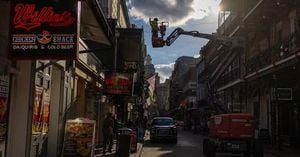On Saturday, November 22, 2025, streets across Canada echoed with the honks of vehicles festooned with Canadian flags, as convoys of farmers and their supporters rolled through major cities and small towns alike. The movement, organized by a group calling itself Farmers Protest Canada, was a direct response to the Canadian Food Inspection Agency’s (CFIA) recent culling of over 300 ostriches at the Universal Ostrich Farm in Edgewood, British Columbia—a decision that has sparked outrage, debate, and a nationwide call for government accountability.
From Vancouver’s congested downtown to the highways of Saskatchewan and the rural roads of Ontario, the convoys created both traffic headaches and a visual display of solidarity. According to CityNews Vancouver, drivers in downtown Vancouver faced heavy congestion as a slow-moving convoy made its way from Langley to Kitsilano. The line of vehicles, horns blaring and flags waving, wound through Gastown and Water Street. “We are driving down Water Street right now, and there is a … convoy running through the streets of Gastown,” a caller told 1130 NewsRadio. “People on the streets are waving, but you might want to tell people to stay away from downtown.”
Vancouver was far from alone. In Saskatchewan, nearly 60 protesters gathered for a slow roll from Martensville to Saskatoon City Hall, as reported by Elissa Miller. The event was one of about fifty rallies held across Canada that day, with the majority concentrated in British Columbia, Alberta, and Ontario. Even smaller communities like Quesnel, B.C., saw over 20 vehicles lined up in front of the railway station, while in Barrie, Ontario, a convoy reminiscent of the Freedom Convoy of years past traveled south on Highway 400, cheered on by supporters waving from overpasses.
The spark for this nationwide protest was the CFIA’s decision to cull the ostriches at Universal Ostrich Farm. The farm, owned by Karen Espersen and Dave Bilinski, had gained international attention in 2021 when it partnered with Japanese scientist Dr. Yasuhiro Tsukamoto to produce Covid-19 antibodies using the birds’ immune systems. By inoculating hens with the dead Covid-19 virus, the farm was able to extract antibodies from egg yolks, reportedly achieving a 99.9% blockage of the coronavirus. These antibodies were then developed into nasal sprays and even sent to Japan for use in nasal drops and candies.
However, the farm’s ambitions came to a halt following an avian influenza outbreak in 2023. While 69 ostriches died, the remaining flock survived and, according to the owners, gained herd immunity. Despite their insistence that no new cases had been recorded and requests for additional testing, the CFIA ordered a cull, citing the risk of the virus mutating and spreading if the flock were allowed to live. The agency’s approach, known as “stamping out,” is an internationally recognized standard for controlling highly pathogenic avian influenza (HPAI), involving the depopulation of infected or exposed animals, disposal of carcasses, and disinfection of premises.
The farm owners fought the decision through the courts, but their final appeal was declined by the Supreme Court of Canada on November 6, 2025. The cull was carried out on November 6 and 7 in a makeshift pen made of hay bales, using marksmen. Animal Justice Canada filed a formal complaint with the CFIA, suggesting the use of more humane methods such as hoods, sedatives, and lethal doses.
For many protesters, the cull was more than just a tragedy for the ostrich farm—it symbolized what they see as a pattern of government overreach and lack of transparency. “I wondered why they weren’t allowed to test their own birds. That really got me,” said Mikhea May, who led the protest in Saskatoon. “They culled them inhumanely. It’s one thing to cull them, but the way they did it was very heartbreaking.” She added, “No more separation. Let’s just educate each other. Let’s not get down on each other. Let’s just unite.”
Others echoed similar sentiments. In Quesnel, Mayor Ron Paull attended as a private citizen, expressing sympathy for the farm owners and criticizing how the situation was handled. “I’m from a farm background, and we still have the family farm in the family,” Paull said. “Pat [his wife] and I visited the ostrich farm back in September, and we’re just very sympathetic to their family and how this whole situation was handled, or mishandled. That’s why I’m here supporting my farmer friends.”
For protester Chris Winther, the ostrich cull was a breaking point for farmers’ rights and government control. “It was the kind of the breaking point that got people thinking that they have to do something,” Winther told local media. He also linked the issue to broader concerns about international influence and red tape in Canada’s industries, saying, “We want more people being aware so that we can stand together against the tyranny of the WEF, the Prime Minister, he’s one of the heads of the WEF, so it’s really obvious what’s going on.”
On the ground in Barrie, protesters carried placards opposing not just the CFIA but also the Royal Canadian Mounted Police, and called for an end to the stamping-out policy. “What we would like to see is a policy change, that the stamping-out policy be abolished,” said one man from Midland. “There are better solutions. There are professionals in Canada that have different solutions where all of the animals won’t need to be slaughtered.”
The CFIA, for its part, maintains that its response follows the World Organisation for Animal Health’s guidelines and is necessary to prevent the spread of HPAI and protect both animal and human health, as well as international trade. Yet, for many of those in the convoys, the issue has come to represent a deeper mistrust of government institutions and a call for greater transparency and respect for farmers’ rights.
As the convoys wound their way through cities and towns, the message from protesters was clear: the ostrich cull may have been the latest flashpoint, but their concerns reach far beyond a single incident. “We’re hoping to save our farmers, our food, our future. The future for our children and our grandchildren,” said protester Tammy Aiello, who witnessed the cull firsthand. “We need to unite together as one to make change in this country, ’cause we’re doing a bad nosedive.”
Saturday’s convoys may have caused traffic jams and drawn the ire of some city dwellers, but for those participating, it was a show of unity and a demand for change—one that they hope will resonate long after the horns fall silent and the flags are put away.




